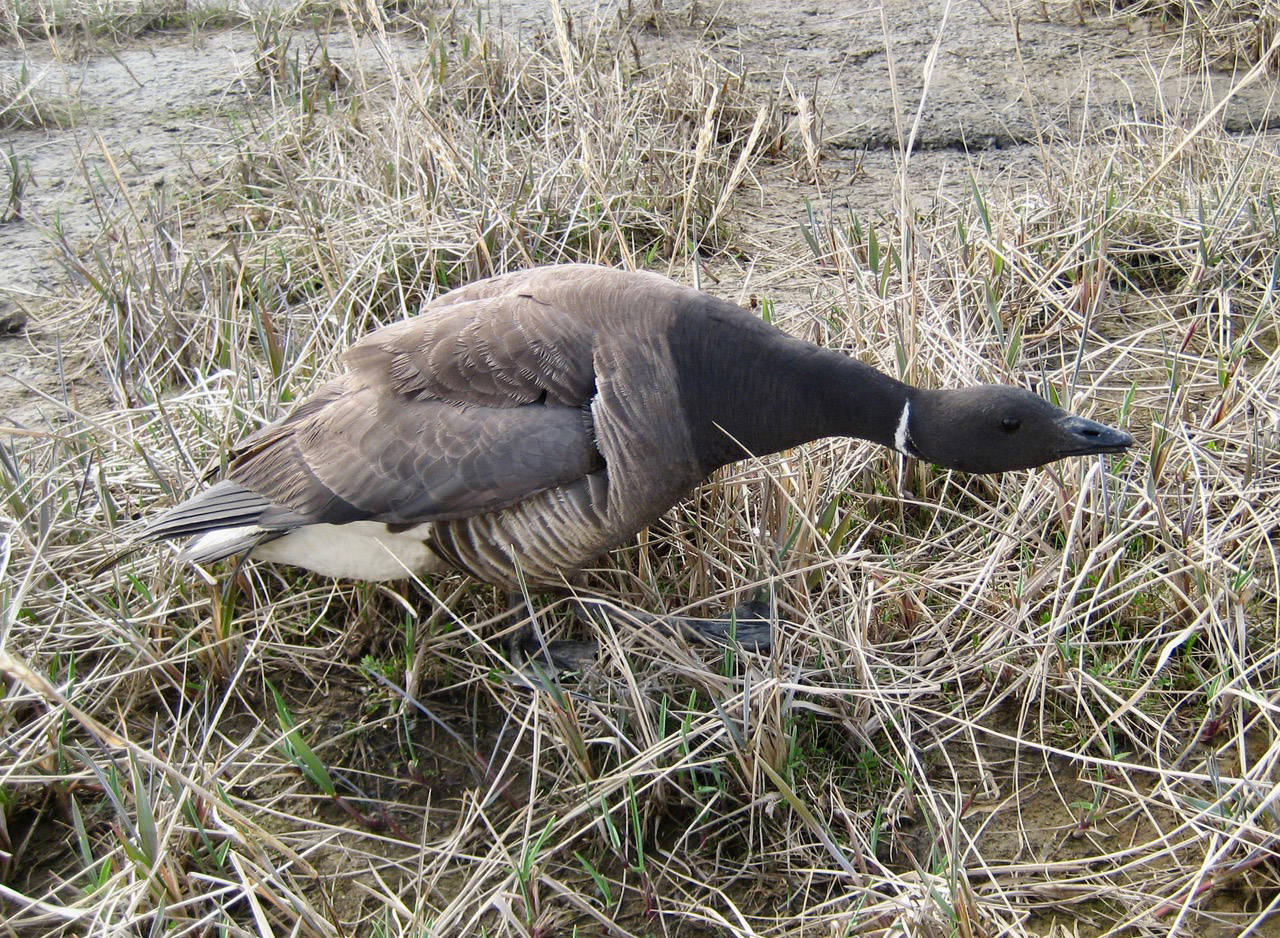This is the first of a two-part series describing a charismatic but lesser known goose species, its past, present and future in the Pacific flyway, and how closely its fortunes have been, and will continue to be, tied to a single, remote natural feature that is protected and managed jointly by federal and state wildlife agencies. The star of this story is a small dark goose called the Pacific brant.
My earliest brant encounter was with Atlantic brant in southern New Jersey. It was October 1976 at Brigantine National Wildlife Refuge in southern New Jersey, during my second week of employment as a Flyway Biologist with the U.S. Fish and Wildlife Service. We spent the day lying in the tall grass at the edge of a marsh, counting young and adult brant through a spotting scope for age ratio data.
That winter we conducted aerial surveys to assess the impact of a record-breaking cold spell on waterfowl. We found brant and other waterfowl dying of starvation by the thousands as extensive sea ice blocked access to their wetland foods. A tough thing to witness when all you can do is record the damage.
Fast forward to 1992 and beyond, living in Alaska. During aerial surveys and banding I became familiar with Pacific brant throughout much of their annual cycle, through arctic breeding, Alaska molting and staging, and wintering mostly farther down the Pacific coast. The unique and fascinating ways they exploit their niche endeared them to me more and more.
Some of their behaviors set them strikingly apart from other geese. When we capture and band geese, usually during the flightless period of their summer molt, most species do what you’d expect. They desperately try to escape during roundup and in holding pens and leave us with scratches and bites from claws and bills during handling.
Not brant. They are astonishingly docile, waddling quietly and cooperatively into the pen and rarely squirming when handled.
Brant also have their own style of flying over water. Most species take off and gain altitude quickly, but brant flocks fly low, wingtips nearly touching the water, usually in very tight linear formations.
That arrangement has definite aerodynamic energy-saving benefits, but is the perfect setup for unintentional “doubles” by hunters — not a good thing if the hunter is one bird short of the two-bird limit!
Perhaps the most significant way brant differ from most other geese is their extreme specialization in food preferences. Most geese are generalist vegetarians, eating grasses and other low herbaceous plants in fresh and saline wetlands and upland habitats, and most are more than happy with grain crop residues, making them highly adaptable in terms of forage and range.
Brant, on the other hand, are all about eelgrass, to the point where it largely defines where they live!
Eelgrass is a marine flowering plant that is kin to neither eel nor grass, but its long, thin, ribbonlike leaves look a little like both. It grows abundantly in shallow lagoons and estuaries in many places around the Northern hemisphere.
Brant graze on the leaves, mostly during low tides where strong tides occur. They will eat small amounts of various other plants in a pinch, and two brant subspecies wintering on either side of the Atlantic made a successful switch to an abundant marine alga called sea lettuce when eelgrass was depleted.
But for our Pacific brant there has been little evidence of (or need for) alternatives to eelgrass. A good thing for hunters, as the usually scrumptious birds are much less so after they’ve been dining on sea lettuce!
Historically estimated between 100,000 to 200,000 individuals, most Pacific brant nest in scattered colonies on tundra coasts of the Yukon-Kuskokwim Delta, Arctic Alaska, western Arctic Canada and northeastern Siberia. But in early fall after their young pass their flight tests they head straight for eelgrass farther south.
There are a couple of well-known, large eel-grass habitats in the Pacific Flyway that are major brant magnets. The main one in Alaska is Izembek Lagoon, an 81,000-acre, shallow estuary located near Cold Bay on the tip of the Alaska Peninsula, managed cooperatively by Alaska Department of Fish and Game and Izembek National Wildlife Refuge.
It’s chock-full of eelgrass, and, together with a few lesser surrounding eelgrass lagoons, the ideal spot for essentially the whole Pacific black brant population to “fuel up” for a few weeks in fall in preparation for their long migration south to wintering areas, and in spring before their final push to arctic breeding grounds. The other leading traditional eelgrass Eden for brant is San Quintin Bay and other lagoons in Baja California, Mexico.
So here’s how the annual post-breeding schedule has presumably gone for untold years since the last ice age: Each late October/early November most of the brant that fattened up at Izembek take to the sky on a north wind.
Some follow the coast and stop to winter in lesser eelgrass habitats widely scattered between Southeast Alaska and San Diego, but over half the population makes an amazing, nonstop, transoceanic flight of 3,170 miles in about 54 hours to San Quintin, Mexico. The return spring flight north is more piecemeal, with shorter hops between eelgrass pit stops.
Stay tuned for the end of my Pacific brant story in a coming edition of the Refuge Notebook, where we’ll look at recent changes in their annual cycle and consider my best guess for their fortunes and adaptability through the next few challenging decades.
Bill Larned is a retired biologist/pilot whose 40 year career has consisted mainly of developing and conducting aerial wildlife population and distribution surveys in many parts of the U.S, Canada and Mexico, along with various other biological work for state and federal agencies. He has lived in Soldotna since 1984. Find more Refuge Notebook articles (1999–present) at https://www.fws.gov/refuge/Kenai/community/refuge_notebook.html.
By BILL LARNED
Refuge Notebook

